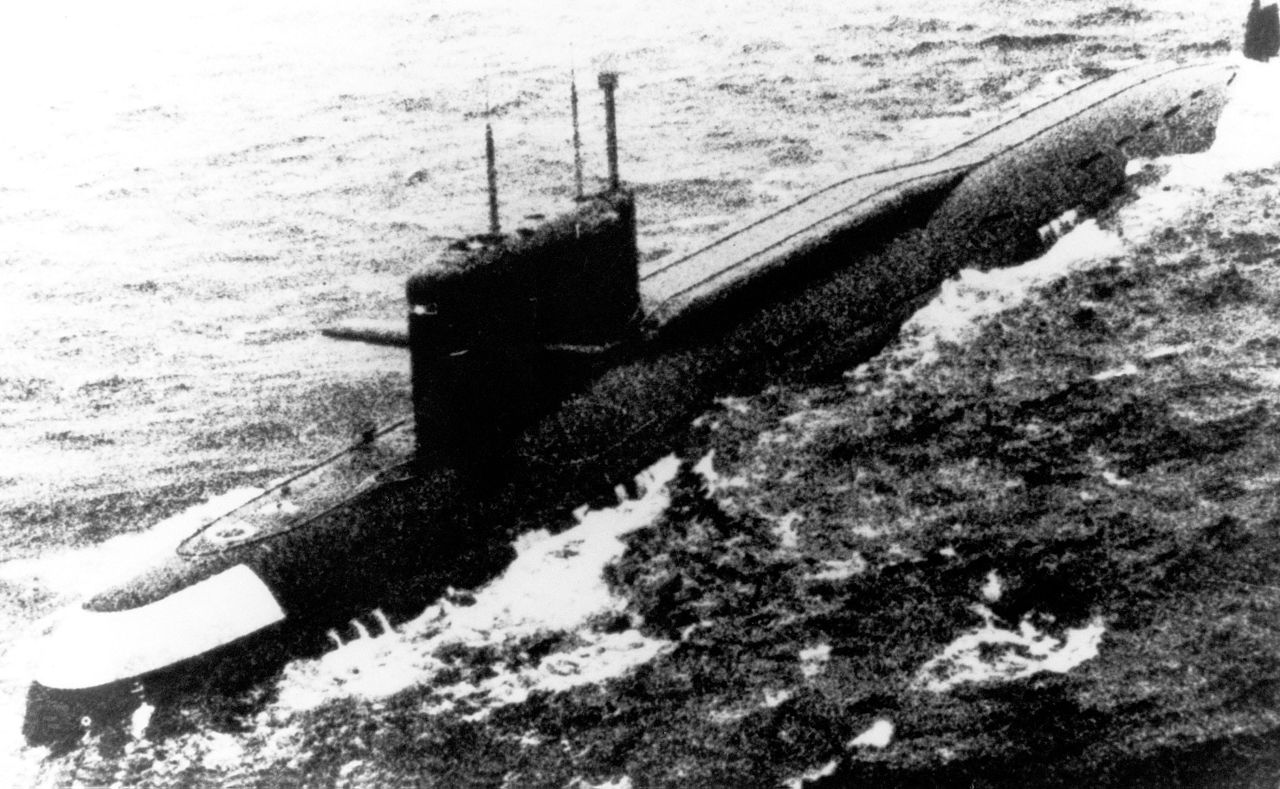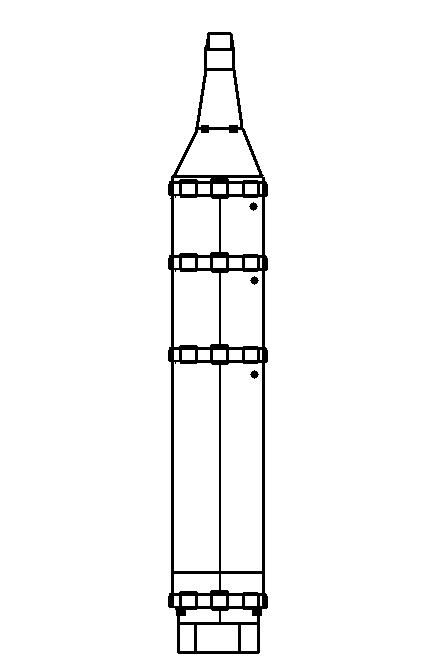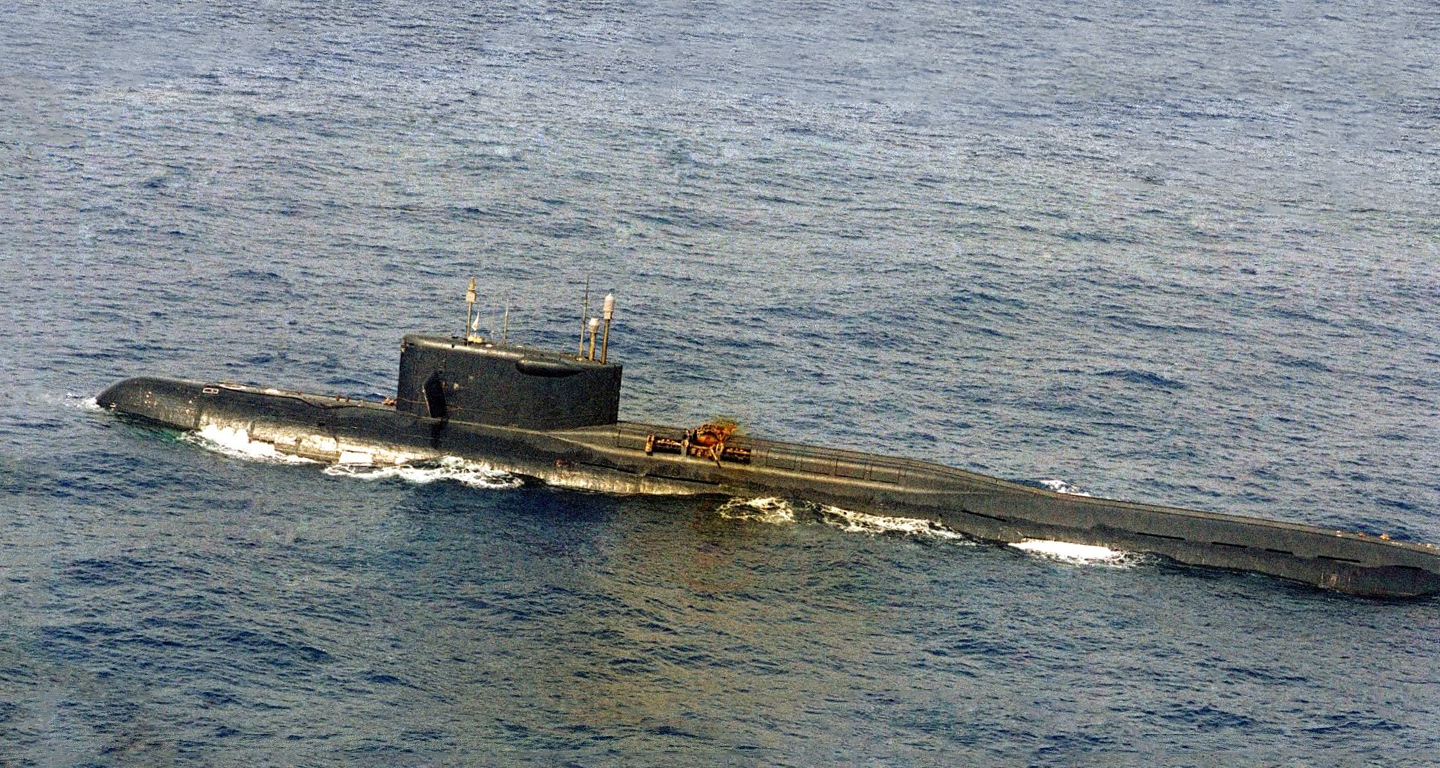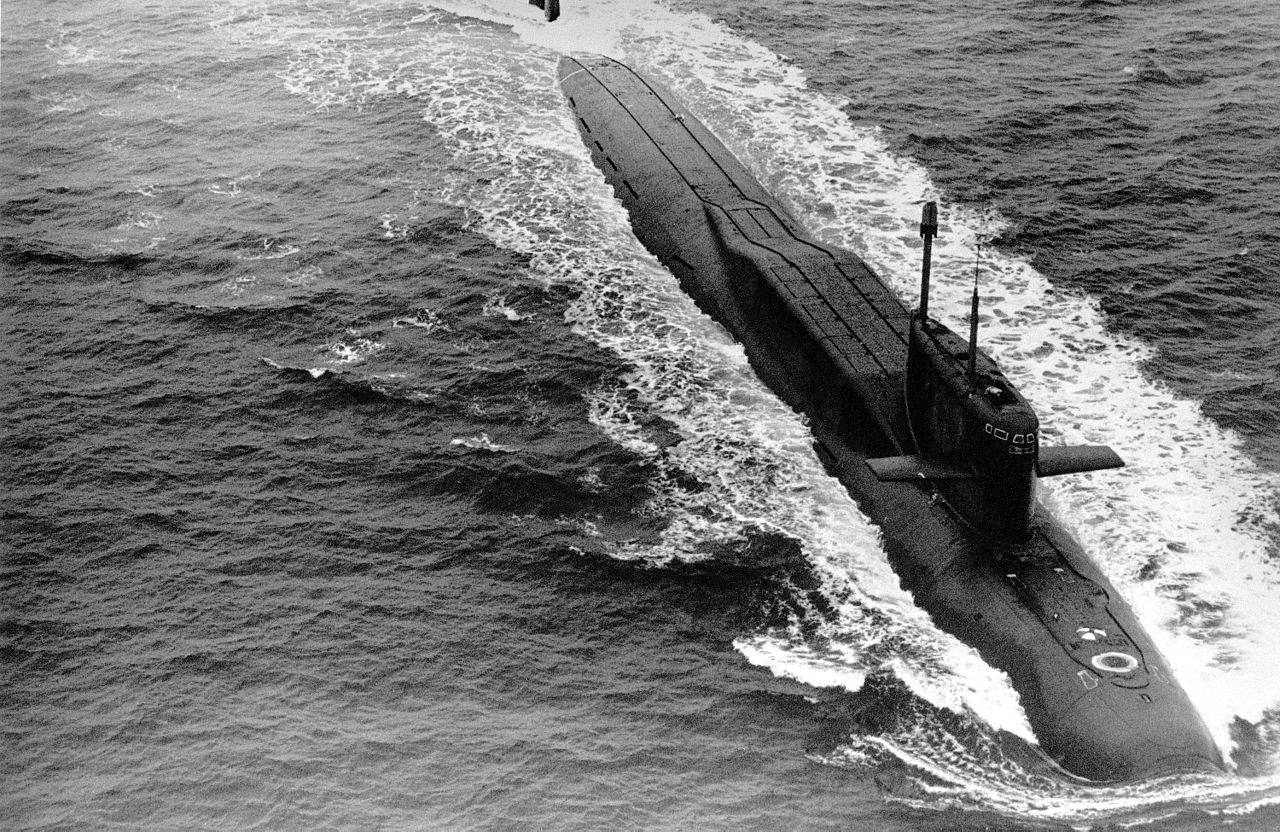While the Soviets were the first to take ballistic missiles to sea, their first generation of submarines were not particularly successful. Each could carry only three or four short-range missiles, making them more suitable for theater strike than attacks on the US mainland. The American Polaris program thoroughly eclipsed these submarines, and it wasn't until 1962 and the aftermath of the Cuban Missile Crisis that the Soviets decided to try again.

A Soviet Yankee class submarine
The initial plan was to build the submarine around 8 of the R-21 missiles that were being refitted to the Golf and Hotel classes. These were capable of underwater launch, but they were large enough that they would have to be carried horizontally, and a complicated mechanism would be required to turn them upright and prepare them for firing. This was quickly dismissed as overcomplicated, and studies were instead made of solid-fueled missiles very much like Polaris.
Unfortunately, Soviet industry of the time simply wasn't up to producing a solid-fuel rocket of acceptable performance, and two separate designs came to grief before they finally went back to liquid fuel in the form of the R-27 missile, known to NATO as the SS-N-6 "Serb". Improvements in rocket design allowed the R-27 to reach 1,350 nm, allowing the submarine carrying it to remain well offshore, in a package smaller than the R-21. Flight tests began in the mid-60s, and while the idea of rearming the Golfs and Hotels was considered, the decision was made to fit it to a new SSBN. The result, known as Project 667A, was more than a little reminiscent of a Polaris boat, with 16 missiles carried in tubes aft of the sail. However, the parallels were little more than skin-deep, as the new submarine, called the Yankee class by the west, had two reactors and two propeller shafts, and was capable of firing its missiles at much higher speeds (3-6 kts instead of stationary) and greater depths (165'/50m)1 than could Polaris. It did have one major drawback: it was far louder than its American counterparts, thanks to the limits of Soviet technology.

R-27 missile
The first Yankee was commissioned in late 1967, just as Polaris boat construction was ending, and the first patrol off the US Atlantic coast followed in mid-1969. 34 were built through 1972, and at that point, it became standard practice to have at least two boats in the Atlantic and one in the Pacific, all within missile range of the US coast.2 In practice, the Soviets found that the range deficit of the R-27 was largely made up for by the fact that the Americans had so much of their vital infrastructure near the coast, while the Polaris boats had to come closer inshore to hit targets in the Russian interior. As the building program wound down, a new missile variant, the R-27U, was introduced. It extended range to 1,620 nm and added an option for a 3-warhead MRV configuration similar to that on Polaris A3. All but one of the existing Yankees were refitted with the new missile, the exception being fitted with 12 R-31s/SS-N-17s, the first Soviet solid-fueled SLBM. This unique boat caused significant confusion in the west, as various theories tried to justify the importance of a single submarine with the new weapon, such as it actually having a secondary satellite-launch capability. In practice, it seems to have mostly been the product of the traditional Russian unwillingness to throw away military hardware. The regular Yankees were also the subject of much speculation, with many believing they were intended to get closer to shore and launch their missiles on a "depressed trajectory", which would be flatter and significantly faster, hopefully taking out important command targets before they could take action. In practice, the R-27 wasn't actually capable of flying a depressed trajectory, and the next generation of Soviet SLBMs would take an entirely different approach.

K-219 on the surface after the accident
And while the Yankees were generally successful, there were definitely problems. In 1979, K-219 suffered a leak in a missile tube, and the water reacted with the volatile liquid propellant,3 causing a serious fire. The crew brought it under control, and K-219 continued to make patrols with 15 missiles until October 1986, when a leak in another tube sparked a fire and explosion that breached the hull. Despite this, the crew managed to bring her to the surface and shut down the reactor, although doing so cost seaman Sergei Preminin his life. An attempt to tow the submarine by a nearby Soviet merchant ship failed, and the crew were forced to evacuate in the face of spreading fire and toxic gas. Ultimately, K-219 sank beneath the waves, and the Soviet Navy tried to blame the leak on a collision with the American attack submarine Augusta, a charge the USN and K-219's captain both deny.

The Yankee II, modified to carry R-31s
But the idea of a collision between an American SSN and a Soviet boomer wasn't the stuff of fantasy. When Yankee patrols began, the USN responded strongly. Previously, NATO ASW concepts had been built around fighting a third Battle of the Atlantic, bringing convoys across to supply the forces fighting in Europe. But the systems worked out for this, barriers that would attrit the Soviet submarine force as it entered the North Atlantic and returned home, would be ineffective against SSBNs, which could cross them in peacetime and then wait in the open ocean, where they would be much harder to track. The American solution was to rely on signals intelligence and SOSUS to alert them when a Yankee was leaving its base, and dispatch an attack submarine to trail it. These trails, hopefully undetected by the target, could last for weeks, and they placed the American SSNs in a prime position to stop missile launches if war broke out. However, this close-range maneuvering was hazardous, and on numerous occasions resulted in submarines from the two sides colliding.4
Despite their limitations, the Yankees would serve throughout the second half of the Cold War. Much like the early Polaris boats, a number were converted during the 1980s into attack submarines by the deactivation of their missile tubes, and a few were even rebuilt with new center sections to carry guided missiles. But while their successors would look similar, they would take a very different approach to the problems of nuclear deterrence. We'll take a look at them next time.
1 This is depth over the missiles, as opposed to traditional submarine depths, which are measured to the keel. Polaris probably had about half the maximum depth. ⇑
2 It's worth noting that a major driver of the Yankee program was the inability of the Soviets to build ICBM guidance systems en masse. The R-27 could use cruder guidance systems that the Soviets could build in large quantities. ⇑
3 R-27 used UDMH and nitrogen tetroxide, both of which are toxic and very reactive. ⇑
4 Augusta was in fact damaged right around the time K-219 went down, but it's more likely that this was in a collision elsewhere in the Atlantic and not with K-219. ⇑

Comments
According to a few reports the Russians surveyed the the K-219 wreck and noticed a couple of things: A few of the missile hatches were open and the missiles were missing.
I wonder how that happened.....
I think I've seen a picture of a Delta class that had a sizable dent in its hull. Roughly the same time it happened, the USS Augusta returned to port with bow damage.
Some things are truly mysterious. Maybe the whales felt a need for a nuclear deterrent.
bean:
That just shifts the mystery.
Yeah, it probably wasn't the whales. K-219 sunk in 1986, but the whaling moratorium was already four years old by that point, so they must have gotten their nuclear deterrent earlier. Or they were making sure it didn't get rolled back...
They had THIRTYFOUR Yankees to be able to keep THREE on patrol outside the US coast?
Sheesh...
Not exactly. They decided to build 34, and kept three on patrol, but I'm pretty sure they could have kept at least, oh, 10 or so on patrol if they'd wanted to. They just didn't for a variety of reasons. Soviet weapons procurement was bizarre, and in a lot of cases, took on a life of its own. I believe that's why they bought so many Yankees. The Deltas were much better suited to their style, as I will explain on Sunday.
I wonder if it's also related to the Soviet Navy's philosophy of keeping "operational" ships tied up at the pier so they could be surged in a crisis, as opposed to the practice of the USN where generally any "operational" ship is forward deployed (or on its way to or from a deployment). Keeping three boomers on patrol off the US coast gave them an emergency capability just in case things went very bad very suddenly; keeping the rest of the boats close to home meant they'd be fully maintained and provisioned and ready to break out if they got a few hours' (or days') notice that things were about to go very bad. Oh, and another benefit from the Soviet POV: they didn't have to extend nearly as much trust to the officers and men of boats tied up alongside in their home ports.
That's pretty much it, actually. I just didn't want to spoil Sunday's post, but I should know better by now.
Given the slow speed of waterships they'd need more than a few days to get into position especially if they have to go slow enough to not be heard by US submarines.
But the words "at least" were included so they could have had more than 3 at a time within range of the US.
The Yankees never made all that much sense for the Soviets for exactly that reason. The Deltas were a much better fit for their style of operations, as I will explain in about 7 hours.
Is there any style of operation where they would've made sense?
Aiming at targets in Europe, probably. The issue was just that they didn't have the range they needed for port basing, and the Soviets weren't set up to keep large numbers forward-deployed.
@Anonymous -
"Given the slow speed of waterships they’d need more than a few days to get into position especially if they have to go slow enough to not be heard by US submarines."
Oh no, I meant that it would take them in between several hours and a couple of days just to cast off their moorings and head out of port. Add another week or so to actually get the boomers into launch position. That might not get them into place in time to participate in a hypothetical Big One, but firing off a boatload of SLBMs a week late would still be very bad news for the US even if it was no longer particularly helpful for Mother Russia.
But keep in mind that a surge wouldn't just be the boomers, it would be the entire ocean-going Soviet navy. That would present a lot of targets to identify and track all at once (and several of the early Soviet sub classes had the same engineering plants in slightly different hulls, complicating target discrimination). Also, the Soviets at this time hadn't realized how easily NATO was tracking their submarines, which certainly would have led them to make... optimistic... assumptions about how successful they would be at breaking out into the Atlantic. (@bean, I don't know if espionage is on-topic for this blog, but if so then the Walker spy ring might be fodder for a post at some point.)